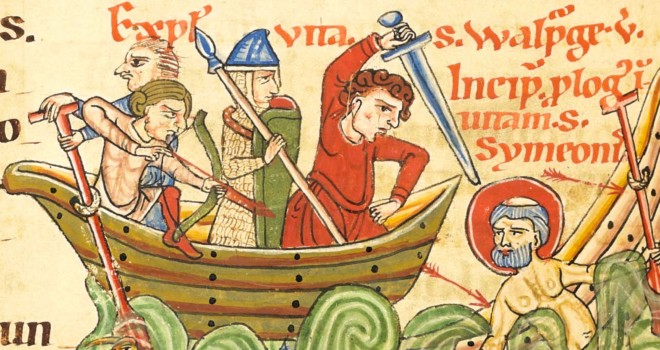Real pirates, both past and present, aren’t amiable. They rape and pillage and kill. They’re nothing to laugh about.
Nevertheless, growing up, I thought of pirates as chummy and amusing when I thought about them at all. And I pretty much only thought about them when my family made its annual summer trek to Southern California for sun, swim, and Disneyland.
“Pirates of the Caribbean” was merely a ride back then (this was way before Johnny Depp), and the buccaneers who populated that ride were all smiles and joviality and “Yo ho, yo ho, a pirate’s life for me.” I imagine it’s the same jokey image of pirates that younger generations adopted after repeated exposure to the VeggieTales Silly Song starring Larry the Cucumber and friends. “Well, I’ve never plucked a rooster and I’m not too good at ping-pong,” sings Larry the slothful swashbuckler. Heh-heh, pirates for kids – you gotta’ love ‘em!
It’s an association that’s in keeping with this hagiographic curiosity: St. Nicholas (as in Santa Claus) is not only a patron saint of children, but also the patron saint of pirates – yet only repentant pirates I’d think. You’d hope that saints wouldn’t be patronizing practicing pirates, right?
Right, although that raises a question: What if you’re dealing with one of the practicing kind? What if you’re sailing the Seven Seas and you get attacked – and it’s not VeggieTale attackers? Since St. Nick is busy with his pirates in rehab, who’s your go-to intercessor going to be?
Some might suggest St. Albinus of Angers, the
6th-century French abbot and bishop who used to ransom members of his flock
who’d been snatched by pirates trawling the Loire River. However, prayers to
St. Albinus would only make sense if you’d been taken by surprise and were
already in fetters. What about a saintly somebody to plead your cause if
pirates are just about to board your vessel – yikes! – and you’re hoping to escape
unscathed?
That, my friend, is the purview of St. Symeon of Syracuse (also known as Symeon of Trier and Symeon of Mt. Sinai). Born in Syracuse, Sicily, around 970, Symeon’s mother was Calabrian, but his father was a Greek military officer, and so the lad was sent to Constantinople for his education. Eventually, Symeon decided upon a life in religion, was ordained a deacon in the Holy Land, and entered the ancient monastery of St. Catherine on Mt. Sinai.
In 1027, Symeon was charged by his abbot to travel to France to collect alms promised by a nobleman, but he was waylaid on the Nile near Alexandria by vicious (that is, decidedly not Disneyland) pirates. Despite the fact that the brigands wiped out the ship’s crew, Symeon somehow managed to escape – pfft! just like that – and he landed in Antioch where he received aid. After that, Symeon made a return trip to the Holy Land and visited Rome, and by the time he finally reached France, the nobleman was dead and the alms were never collected.
All that adventuring took its toll on Symeon, and he decided to skip the return trip to Egypt. Instead, in 1030, the settled as a recluse hermit in Trier, Germany, at the invitation of the archbishop there. Symeon was enclosed in a tower where he lived a life of prayer and fasting until his natural death on June 1, 1035.
By all means, then, if you’re setting out for a leisurely cruise or a Gilligan-esque “three hour tour,” keep St. Symeon in mind and be ready to enlist his prayers in case you spy a Jolly Roger on the horizon.
Landlubbers can invoke him as well, of course, although the pirates we face today tend to be less bloodthirsty and more given to subtler forms of plunder. “Aargh, me hearties! Your credit card interest is 18% and payment is past due!”
St. Symeon, pray for us. Ahoy!













